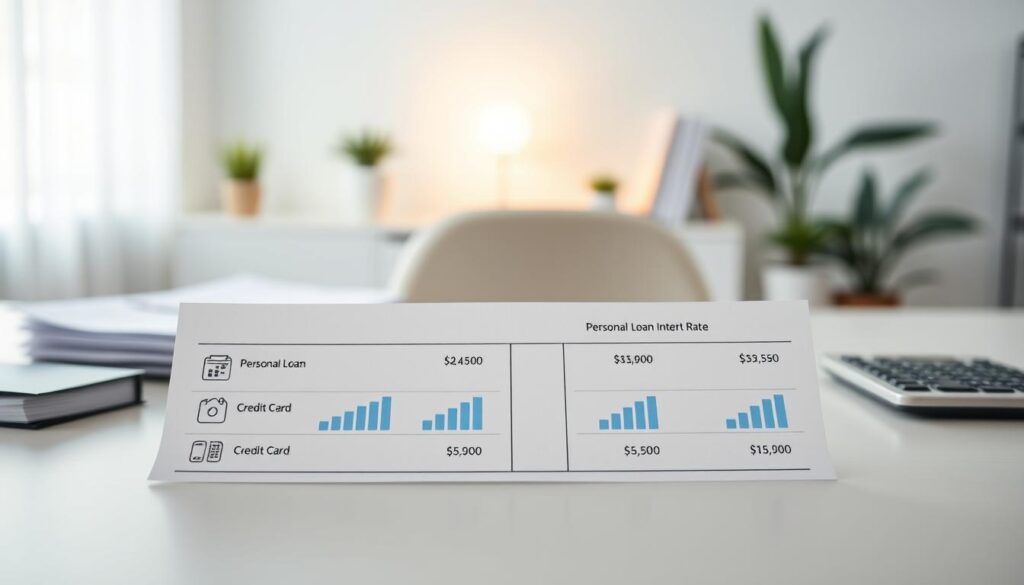Discover the Best Personal Loans for Your Needs
Did you know that over 26 million Americans took out a personal loan in 2022? The average loan was around $8,000.
When looking at loans, it’s key to know your options. We can use loans for many things, like paying off debt or covering unexpected costs.
By checking out different lenders, we can find the best loan options for us. This way, we get low interest rates and good terms.
Key Takeaways
- Understand the various personal loan options available.
- Explore different lenders and their offerings.
- Look for low interest rates and favorable terms.
- Consider loan flexibility for different financial needs.
- Research and compare loan options to find the best fit.
Understanding Personal Loans
Exploring personal finance can seem overwhelming. But, understanding personal loans is key to financial freedom. Personal loans are flexible and can meet various needs, like paying off debt or funding home improvements.
What Are Personal Loans?
A personal loan is an unsecured loan that lets you borrow money without needing collateral. This loan flexibility allows you to use the funds for unexpected bills, debt consolidation, or other financial goals.
Unlike secured loans, personal loans don’t require collateral. This makes them easier for many people to get.
Types of Personal Loans
There are many types of personal loans, each suited for different financial needs.
- Unsecured Personal Loans: These are the most common, needing no collateral.
- Secured Personal Loans: These require collateral but might have lower interest rates.
- Online Personal Loans: Many lenders offer online applications, making it easy to apply from home.
How Personal Loans Work
It’s important to understand how personal loans work to make smart financial choices. When you apply, lenders check your credit to set the loan’s terms, like interest rates and repayment periods.
After approval, you get the loan amount. You then pay it back in installments over the agreed term. Always read the loan terms and any fees carefully.
Benefits of Personal Loans
Personal loans have many benefits, making them a good choice for different needs. They are often easier to manage than other credit options.
Consolidating Debt
One big plus of personal loans is they help with debt consolidation. They combine several debts into one, making it simpler to manage. This can also lower your interest rate and monthly payments.
Debt consolidation is great for those with high-interest credit card debt. It can save money on interest and help pay off debt faster.
Emergency Expenses
Personal loans can also help with unexpected expenses. They provide funds for emergencies like medical bills or car repairs. This way, you don’t have to use your savings or retirement funds.
Having a personal loan for emergencies gives you peace of mind. It’s helpful for those without a big emergency fund.
Home Renovations
Personal loans are also good for home renovations. They don’t require using your home as collateral, which is safer for some. This makes them a good choice for financing improvements.
Using a personal loan for home improvements can boost your property’s value. It’s a good option for those wanting to enhance their home without a huge upfront cost.
In summary, personal loans offer many benefits for various financial needs. They help with debt consolidation, cover emergencies, and fund home improvements. Understanding these benefits can help you make better financial choices.
How to Choose a Personal Loan
To choose a personal loan wisely, you need to look at several important factors. With so many choices, selecting the right personal loan can greatly affect your finances.
Interest Rates Considerations
The interest rate is a key factor in picking a personal loan. Lenders offer different APRs, so it’s important to compare them. Low interest personal loans can save you a lot on interest over time.
As
“The interest rate on your personal loan can greatly affect your monthly payments and overall cost.”
It’s crucial to understand how interest rates work and how they apply to your loan.
Loan Terms and Fees
Looking at the loan terms and fees is also essential. Loan terms and fees can vary a lot between lenders. Knowing these can help you avoid problems. Watch out for origination fees, late payment fees, and prepayment penalties.
- Origination fees: These are fees charged by the lender for processing the loan.
- Late payment fees: These are penalties for missing a payment or making a late payment.
- Prepayment penalties: Some lenders charge a fee for paying off the loan early.
Lender Reputation
The reputation of the lender is also very important. Look into the lender’s customer service, read reviews, and understand their practices. A good lender will be clear about their loan products and terms.
When checking personal loan lenders, look at their online presence and customer reviews. Online personal loans are often quick and convenient.
Factors Influencing Personal Loan Rates
Knowing what affects personal loan rates helps you make smart borrowing choices. Several key elements influence the interest rate you’ll get.
Credit Score Impact
Your credit score plays a big role in your loan rate. A good credit score means you’re seen as a reliable borrower, leading to lower rates. On the other hand, a bad score can mean higher rates or even no loan at all.
Credit Score Tiers and Corresponding Interest Rates
| Credit Score Tier | Interest Rate Range |
|---|---|
| Excellent (750+) | 6% – 10% |
| Good (700-749) | 8% – 14% |
| Fair (650-699) | 12% – 18% |
| Poor (Below 650) | 18% – 25%+ |
Income and Employment History
Lenders look at your income and job history to see if you can pay back the loan. A steady income and long job history are good signs. But, if you’re self-employed or have an irregular income, you might face higher rates.

Loan Amount and Term
The loan amount and term also affect your rate. Shorter terms usually mean lower rates, while longer terms might have higher rates. Also, bigger loans can sometimes get better rates, even though they’re riskier for lenders.
Understanding these factors can help you find better loan rates. This way, you can make more informed borrowing decisions.
The Application Process for Personal Loans
Applying for personal loans can seem tough, but knowing the steps helps. Being ready and informed makes the process smoother. This ensures a successful application.
Steps to Applying
Getting a personal loan involves a few easy steps. First, check your credit score because it affects your loan eligibility. Then, compare different loan options from various lenders. Look at interest rates, terms, and fees.
After picking a lender, submit your application with personal and financial details. This includes your income, job history, and current debts. Make sure to fill out the application accurately and completely to avoid delays.
Required Documentation
The documents needed for a personal loan vary by lender. But, you usually need proof of income, like pay stubs or tax returns. You’ll also need identification and proof of residence, such as a utility bill.
Some lenders might ask for more, like bank statements or details of your existing debts. Having all the necessary documents ready can make the application process easier.
Common Mistakes to Avoid
When applying for a personal loan, avoid some common mistakes. Not checking your credit report before applying can harm your score. Also, don’t borrow more than you need to avoid high monthly payments.
Another mistake is not reading the fine print, which can lead to unexpected fees. Always compare offers from different lenders to get the best deal.
Personal Loan vs. Credit Card
Personal loans and credit cards are different financial tools. Each has its own benefits and drawbacks. It’s important to think about your financial needs and goals when choosing.
Interest Rate Comparison
One key difference is in interest rates. Personal loans have fixed interest rates. This means your monthly payments stay the same. Credit cards, on the other hand, have variable interest rates. These rates can change, leading to higher interest over time.

Repayment Flexibility
Repayment flexibility is another important factor. Personal loans have a fixed repayment term. This lets you plan your finances better. Credit cards offer more flexibility, but paying only the minimum can extend the payoff period and increase interest.
When to Choose Each Option
Choosing between a personal loan and a credit card depends on your financial situation. Personal loans are good for consolidating debt or financing big expenses. Credit cards are better for smaller, ongoing expenses.
Top Personal Loan Providers in the U.S.
In the world of personal loans, some U.S. lenders really stand out. They offer great rates and flexible terms. When picking a lender, think about interest rates, loan terms, fees, and customer service.
SoFi
SoFi is a big name in personal loans. They have competitive rates and flexible terms. They help many borrowers, from those looking to pay off debt to those needing funds for home improvements.
Key Features:
- Competitive interest rates
- Flexible loan terms
- No fees for origination, late payments, or prepayment
- Career coaching and financial planning resources
Marcus by Goldman Sachs
Marcus by Goldman Sachs is another top lender. They offer personal loans with good terms. They are known for being simple and clear.
Key Features:
- No fees for origination, late payments, or prepayment
- Competitive interest rates
- Flexible loan terms
- No minimum loan requirements in some cases
LightStream
LightStream, a part of SunTrust Bank, has personal loans with great rates and terms. They are famous for their Rate Beat Program. This program ensures the lowest rate for qualified borrowers.
Key Features:
- Competitive interest rates
- No fees for origination or late payments
- Flexible loan terms
- Rate Beat Program guarantee
To understand the differences, let’s look at a comparison table:
| Lender | Interest Rates | Fees | Loan Terms |
|---|---|---|---|
| SoFi | Competitive rates starting from 4.99% | No origination, late, or prepayment fees | 2-7 years |
| Marcus by Goldman Sachs | Competitive rates starting from 6.99% | No origination, late, or prepayment fees | 6-7 years |
| LightStream | Competitive rates starting from 4.99% | No origination or late fees | 2-7 years |
By comparing these top lenders, you can choose the best one for your needs.
How to Improve Your Chances of Approval
To boost your chances of getting a personal loan, focus on building a strong financial profile. Lenders look at many factors, including what credit bureaus say about you.
Building Better Credit
Improving your credit score is key. Make on-time payments and keep your credit use low. A good score shows lenders you’re reliable.
For example, paying bills on time and in full boosts your score. Check your credit report often to spot errors that could hurt your score.
Reducing Existing Debt
Lowering your debt also helps. High debt levels make you seem riskier to lenders. Paying down debt improves your debt-to-income ratio, making you more appealing for a loan.
Make a debt repayment plan to stay focused. Also, check out tips for personal loan applications to boost your chances.
Creating a Strong Financial Profile
A strong financial profile is more than just a good credit score. It also includes your income, job history, and overall financial health. Lenders want to see steady income and a solid job record.
| Financial Profile Component | Description | Importance |
|---|---|---|
| Credit Score | A numerical representation of your creditworthiness | High |
| Income | Your regular earnings from employment or other sources | High |
| Employment History | A record of your past and present employment | Medium |
| Debt-to-Income Ratio | A comparison of your monthly debt payments to your income | High |
By working on these areas and showing a complete financial picture, you can greatly increase your chances of getting a personal loan.
Using Personal Loans Wisely
Using personal loans wisely means knowing a lot and planning well. When we borrow money, we must understand our finances and goals clearly.
Responsible Borrowing Practices
Responsible borrowing is key to using personal loans wisely. It means knowing the loan terms, like the interest rate and repayment period. “Borrowing is not just about getting the money you need; it’s about understanding the commitment you’re making to repay it,” as financial experts often say.
To borrow responsibly, we must check if we can repay the loan without financial strain. We should look at our income, expenses, and current debts. This helps us avoid over-borrowing and ensures we can afford the repayments.
Avoiding Common Pitfalls
Avoiding common pitfalls is vital when getting a personal loan. One big trap is hidden fees, which can raise the loan’s total cost. Always read the fine print and ask about extra charges.
Another trap is not seeing the loan’s total cost over time. Focusing only on the monthly payment can hide the true expense. It’s important to calculate the total repayment to grasp the loan’s full cost.
Budgeting for Repayment
Budgeting for repayment is crucial when using personal loans wisely. By setting aside a part of our budget for loan repayment, we can make timely payments and avoid late fees.
To budget well, we should list our expenses and include loan repayment. “Creating a budget is not about cutting out the things you enjoy, but about making room for what’s truly important, including paying off your debt,” a financial advisor might advise.
By borrowing responsibly, avoiding common mistakes, and budgeting for repayment, we can use personal loans to our advantage. This way, we can reach our financial goals without stress.
Frequently Asked Questions About Personal Loans
When we explore personal loans, many questions come up. Knowing these common questions helps us understand better. It also aids in making smart choices.
Borrowing Limits
The amount we can borrow changes based on the lender and our credit score. Lenders usually offer loans from $1,000 to $50,000 or more. It’s important to pick an amount that matches our financial goals.
Loan Term Options
Loan terms range from 2 to 7 years. We need to pick a term that suits our financial situation. It’s a matter of weighing the benefits of shorter versus longer terms.
Early Repayment
Pay off a loan early to save on interest. Before making extra payments, check if there are penalties. This ensures we avoid any extra costs.









